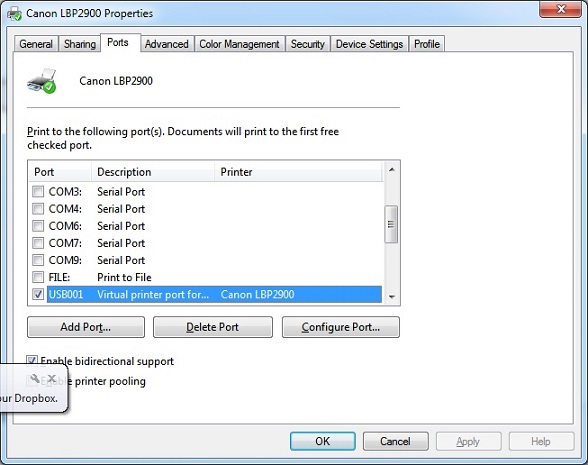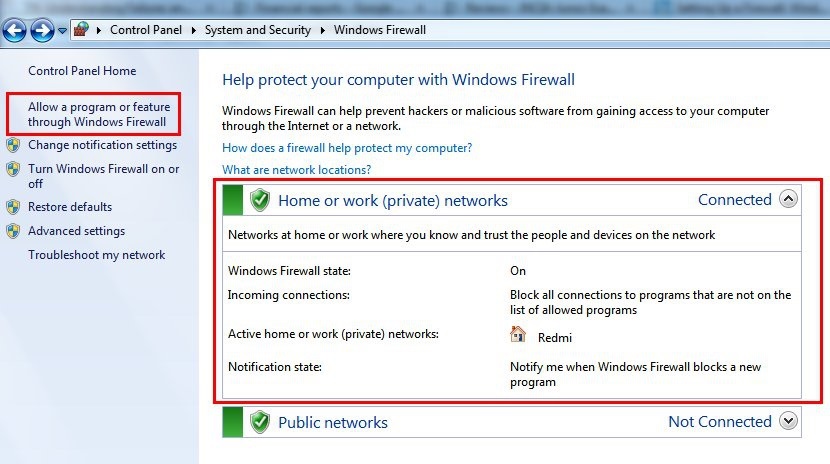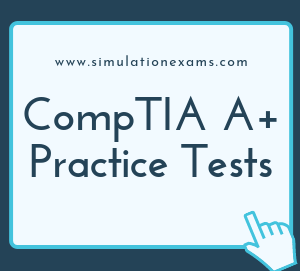RETIRED!
Features of Windows7:
1. Only 64 bit versions of windows 7 can handle over 4GB of memory (RAM).
2. The following table specifies the limits on physical memory for Windows 7.
| Version | Limit on x86 | Limit on x64 |
|---|---|---|
| Windows 7 Ultimate | 4 GB | 192 GB |
| Windows 7 Enterprise | 4 GB | 192 GB |
| Windows 7 Professional | 4 GB | 192 GB |
| Windows 7 Home Premium | 4 GB | 16 GB |
| Windows 7 Home Basic | 4 GB | 8 GB |
| Windows 7 Starter | 2 GB | 2 GB |
3. Both the 32 bit and 64 bit versions of Windows 7 require minimum 1 GHz
If you want to run Windows 7 on your PC, given below are the hardware requirements:
4. The automatic restart option in Windows 7 is enabled by default. As a result, if there is any major error, the Operating System will automatically restart.
5. In a Windows 7 computer, go to Control Panel\Hardware and Sound\Devices and Printers and right click on appropriate printer. Click on "Printer Properties" to open the properties window of the chosen printer. Click on Ports tab to view the port on which a printer is connected. A typical screen-shot is shown below:

Windows 7 Start-Up Options:
Windows 7 advanced startup options can be accessed by pressing F8 key when prompted during the beginning of the Windows 7 boot process. The following options will be made available:
1. Repair Your Computer:Shows a list of system recovery tools you can use to repair startup problems, run diagnostics, or restore your system. This option is available only if the tools are installed on your computer's hard disk. If you have a Windows installation disc, the system recovery tools are located on that disc.
2. Safe Mode:Starts Windows with a minimal set of drivers and services. For more information.
3. Safe Mode with Networking:
4. Safe Mode with Command Prompt:Starts Windows in safe mode with a command prompt window instead of the usual Windows interface. This option is intended for IT professionals and administrators.
5. Enable Boot Logging: Creates a file, ntbtlog.txt, that lists all the drivers that are installed during startup and that might be useful for advanced troubleshooting.
6. Enable low-resolution video (640x480):Starts Windows using your current video driver and using low resolution and refresh rate settings. You can use this mode to reset your display settings.
7. Good Configuration (advanced):Starts Windows with the last registry and driver configuration that worked successfully. For more information.
8. Directory Services Restore Mode:Starts Windows domain controller running Active Directory so that the directory service can be restored. This option is intended for IT professionals and administrators.
9. Debugging Mode:Starts Windows in an advanced troubleshooting mode intended for IT professionals and system administrators.
10. Disable automatic restart on system failure: Prevents Windows from automatically restarting if an error causes Windows to fail. Choose this option only if Windows is stuck in a loop where Windows fails, attempts to restart, and fails again repeatedly.
11. Disable Driver Signature Enforcement:Allows drivers containing improper signatures to be installed.
12. Start Windows Normally:Starts Windows in its normal mode.
Window vista features:
1. Windows Vista Security Center secures a PC by alerting when a security software is out of date or when your security settings should be strengthened. The Security Center also displays your firewall settings and automatic updates are enabled or not.
2. The gpedit.msc can be used in Win Vista/7 at the Run command prompt.
3. Windows Vista Home Basic, Vista Home Premium, and Vista Starter provide only limited support for EFS (Encrypted File System), whereas Vista Business, and Vista Ultimate provide full support for EFS.
Note the following important points regarding various versions of Windows Operating Systems:
1. In Windows 7, a user may hide any displayed Update by right clicking on it and selecting "hide" option.
2. In Windows 7, Updates are commonly known as "Important", "Required", and "Optional". Important updates are those that relate to security and stability of the Operating System. Required updates are those that relate to added features, etc. Optional updates are the ones that pertain to device drivers, language packs, etc.
3. In Windows 7, a user may opt to manually update any Windows Updates by selecting appropriate options in the Updates applet.
4. Windows 10 periodically checks for updates. If you want to check manually, select the Start button , then select Settings > Update and security > Windows Update > Check for updates. If Windows Update says that your PC is up to date, then you have all the updates that are currently available for your PC
5. All updates in Windows 10 are automatically downloaded and installed. You cannot selectively update here or disable Windows 10 update. However, there is way to prevent Windows 10 OS to notify and ask for downloading the updates. If the data connection is marked as "metered" then Windows 10 will not download and install the updates automatically. It will only notify when the updates are available.
6. You can not perform an upgrade in any of these scenarios. You need to migrate (do fresh installation) from XP to Windows 7, also you cannot upgrade from 32 bit to 64 bit.
7. You can enable or disable the CTRL+ALT+DELETE sequence for logging on in Windows Vista, Windows 7, and 8/8.1.
8. You can require users to press CTRL+ALT+DELETE before logging on to a Windows Vista-based computer or a Windows 7-based computer, or you can eliminate this requirement for a faster logon process. Note that you must be logged on with Administrator rights to enable or disable CTRL+ALT+DELETE login.
9. Disabling the CTRL+ALT+DELETE sequence creates a "security hole." The CTRL+ALT+DELETE sequence can be read only by Windows, ensuring that the information in the ensuing logon dialog box can be read only by Windows. This can prevent rogue programs from gaining access to the computer. Microsoft recommends that you enable CTRL+ALT+DELETE for login.
10. Set up the drive in the BIOS is incorrect because today's computer's BIOS should see the drive automatically with no configuration needed. In special cases a hard disk might require special drivers.
11. If your Microsoft Windows 7- based computer does not start correctly or if it does not start at all, you can use the Windows Recovery Options to help you recover your system software.
12. Drivers developed for 32-bit versions of Windows 7 are not compatible with 64-bit versions of Windows 7, and vice a versa.
13. Windows Vista supports the FAT16, FAT32, and NTFS file systems.
14. Windows 7 supports Media Center. Though Windows 7 Home Premium also supports it, it is advisable to go for Windows 7 Professional for company use.
15. In Windows Vista Home Basic and Windows Vista Business editions, Media Center is not available.
16. Windows Vista and Windows 7 Operating Systems use Service Packs. However, Microsoft had discontinued with the Service Packs from Windows 8 onwards. So, Windows 8, Window 8.1, and Windows 10 use only UPDATES to implement changes to the Operating Systems. For a big update to Windows 8, Microsoft released Windows 8.1. They have added a revision number instead of a Service Pack. The UPDATES are continual in nature, and usually referred to as Important, Recommended, and Optional.
17. In Windows 7, you can start the Windows Update applet by going to Control Panel > Windows Update.
Windows Vista and Windows 7 feature a user interface termed as Aero by Microsoft. This is the default interface used by Vista. Aero interface is characterized by the following features:
1.Glass-like translucent design
2. Dynamic windows: When you minimize a window, it animates to its place on the taskbar, so it's easier to find when you need it.
3. High dots-per-inch (dpi) support: Windows Aero supports high-resolution monitors, so you can get a laptop or flat-screen monitor that's smaller in size but shows visually richer, displaying high-resolution, easy-to-read images.
4. Live taskbar thumbnails: In Windows Aero, live taskbar thumbnail images display the actual contents of both windows that are currently open and those that are minimized in the taskbar.
5. When you rest your mouse pointer on a tile on the taskbar, you'll see the "live" contents of that window without having to bring it to the foreground.
6. Other features include Windows Flip 3D, and smooth scrolling desktop.
7. The GUI used in Windows Vista is named as Aero.
8. Advanced Boot Options is the menu that can be accessed by pressing F8, which is available in 7/Vista. It is also referred to as ABOM
The editions below support the Aero Feature:
Similarly, Aero desktop is available in
32-bit vs. 64-bit: If you want to move from a 32-bit version of Windows to a 64-bit version of Windows 7 or vice versa, you'll need to back up your files and choose the Custom option during Windows 7 installation. Then, you'll need to restore your files and reinstall your programs.
32-bit Operating systems (especially, workstation Operating Systems such as Win 7 32-bit) usually support only up to 4GB of memory due to address bus limitation. It is recommended to go for 64-bit operating system if you want to use more than 4 GB of memory.
Windows XP Mode for Windows 7 makes it easy to install and run your applications for 32-bit Windows XP directly from your Windows 7 32-bit or 64-bit based PC. It utilizes virtualization technology such as Windows Virtual PC to provide a Virtual Windows XP environment for Windows 7. Windows XP Mode provides only Windows 7 Professional, Ultimate, or Enterprise users the flexibility to run many older productivity applications in a virtual Windows XP environment on a Windows 7-based PC.
Windows Upgrade:
Upgrades to Windows 7 from the following operating systems are not supported:
Windows 95, Windows 98, Windows Millennium Edition, Windows XP, Windows Vista RTM, Windows Vista Starter, Windows 7 M3, Windows 7 Beta, Windows 7 RC, or Windows 7 IDS
Windows NT Server 4.0, Windows 2000 Server, Windows Server 2003, Windows Server 2008, or Windows Server 2008 R2 Cross-architecture in-place upgrades (for example, x86 to x64) are not supported. Supported Upgrade Scenarios
When you upgrade to Windows Vista, you need to ensure that you have software upgrade packs available. It is very much possible that an application that was working properly may not work the same way after the upgrade of OS. You need to contact the vendor for upgrade pack for any application(s) you are using. If the upgrade packs are not available, and if the application is critical, you may need to reconsider the upgradation of OS.
| From Win Vista (SP1, SP2) | Upgrade to Win 7 |
|---|---|
| Business | Professional, Enterprise, Ultimate |
| Enterprise | Enterprise |
| Home Basic | Home Basic, Home Premium, Ultimate |
| Home Premium | Home Premium, Ultimate |
| Ultimate | Ultimate |
Windows 7 Professional can be upgraded to only Windows 7 Ultimate. The possible upgrade scenarios from one edition of windows 7 to another edition of windows 7 are given below
| From Windows 7 | Anytime Upgrade to Windows 7 |
|---|---|
| Home Basic | Home Premium, Professional, Ultimate |
| Home Premium | Professional, Ultimate |
| Professional | Ultimate |
| Starter | Home Premium, Professional, Ultimate |
Windows Sidebar:
Windows Sidebar is a pane on the side of the Microsoft Windows Vista desktop where you can keep your gadgets organized and always available. Gadgets are mini programs that give you information at a glance and provide access to frequently used tools. Windows Sidebar helps you to organize your gadgets. The Windows sidebar is also available in Windows 7 Operating System. Windows Vista and Windows 7 feature a side bar that can be filled with gadgets. Gadgets are small applications that do not consume much system resources, such as weather or calendar.
BitLocker is available in the Enterprise and Ultimate editions of Windows Vista and Windows 7. It is also available in the Pro and Enterprise editions of Windows 8.
BitLocker drives can be encrypted with 128 bit or 256 bit encryption. BitLocker protects your hard drive from offline attack. This is the type of attack where a malicious user will take the hard drive from your mobile machine and connect it to another machine so they can harvest your data. BitLocker also protects your data if a malicious user boots from an alternate Operating System. With either attack method, BitLocker encrypts the hard drive so that when someone has physical access to the drive, the drive is unreadable.
The default spool folder is located at: %SystemRoot%\SYSTEM32\SPOOL\PRINTERS . For example, if the OS is residing on C drive, the default location will be: C:\Windows\System32\spool\PRINTERS
BitLocker Drive Encryption is a full disk encryption feature included with the Ultimate and Enterprise editions of Microsoft's Windows Vista and Windows 7 desktop operating systems.
In order for BitLocker to operate, the hard disk requires at least two NTFS-formatted volumes: one for the operating system (usually C:) and another with a minimum size of 100MB from which the operating system boots. BitLocker requires the boot volume to remain unencrypted, so the boot should not be used to store confidential information.
Only the Ultimate version of Windows 7 comes with Bitlocker and BitLocker To Go. Improved for Windows 7 and available in the Ultimate edition, BitLocker helps keep everything from documents to passwords safer by encrypting the entire drive that Windows and your data reside on. Once BitLocker is turned on, any file you save on that drive is encrypted automatically.
A Trusted Platform Module (TPM) is a microchip that is built into a computer. It is used to store cryptographic information, such as encryption keys. Information stored on the TPM can be more secure from external software attacks and physical theft.
BitLocker uses the TPM to help protect the Windows operating system and user data and helps to ensure that a computer is not tampered with, even if it is left unattended, lost, or stolen.
In addition, please note the following:
DOS, and Windows 7/8/8.1 operating systems share the following criteria:
1. Each can have only one primary partition per hard disk
2. The primary partition is automatically assigned a drive letter
3. Each hard disk can have only one Extended partition
4. You can create one or more logical drives in the Extended partition.
5. When you create a logical drive in Windows 7, drive letter is automatically assigned. However, you can change the drive letter later.
Windows Firewall: Firewall is one of the most important security software on your Windows 7/8/8.1 computer. Windows 7/8/8.1 include firewall to protect the computer against Malware, Malicious software and unwanted programs from internet and intranet. Firewall monitors both the incoming and outgoing connections.
Microsoft Windows 7 comes pre-installed with a software firewall utility. Enabling the Windows 7 firewall:
Control panel -> System and security -> Windows Firewall -> Turn Windows Firewall on or off

Using Home network option you can see the computers that are connected to the network private network. We can share files or folders to the networked computer. You can change the settings to disable the access to the shared folder and files. Public network should be configured in order to reduce the risk, because public network connections are not secured network, so do not use bank web sites or other sites that requires personal or sensitive information. By default it will notify the unauthorised incoming connection to the computer.
It is possible to configure programs that are allowed/dis-allowed. A sample screen-shot of allowed/disallowed programs is shown below:

In Windows 7 we can create multiple profiles and it can be applied to the private and public network. Each connection will use the assigned profile and it will use the rules that are configured in the profiles.
Action Center:Action Center is a central place to view alerts and take actions that can help keep Windows running smoothly. You can use either of the below ways to open Action center utility:
1. Start > run > wscui.cpl
2. Start > Control Panel > System and Security> Action Center

